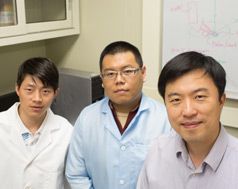From shaving nicks to paper cuts to lacerations, every rupture of a blood vessel triggers a chain reaction of sensing, signaling, anchoring and clustering as the body’s cells and proteins mobilize to form a blood clot.
The actors in this drama, says Frank Zhang, achieve an elaborate choreography enabling platelets—the tiny cell fragments that respond first to a wound site—to form a plug and then a thrombus that seals the wound.
Scientists know what happens at the molecular level to bring about blood clotting, but they have been unable to explain how platelets sense the mechanical force that activates them and instructs them to adhere to injured blood vessels.
Zhang, an assistant professor of mechanical engineering and mechanics, and his colleagues recently shed light on this phenomenon by identifying a critical interaction involving platelets, flowing blood and the protein, von Willebrand factor (VWF), which facilitates clotting and prevents unchecked bleeding.
Using a laser technique called optical tweezers, the group has isolated and immobilized individual platelet and VWF molecules, subjected them to very slight mechanical forces and observed their interaction. They have discovered a “hitherto unidentified mechanosensitive domain” (MSD) in a protein molecule on the surface of the platelets.
“Our hope is that this will help lead to the development of a drug that will treat or prevent disease,” he says, “either by protecting MSD or by preventing the unnecessary activation of platelets.”
Zhang and his colleagues, who have received funding from the National Institutes of Health, recently reported their findings in Blood, the journal of the American Society of Hematology. Their article was titled “Identification of a juxtamembrane mechanosensitive domain in the platelet mechanosensor glycoprotein Ib-IX complex.”
The lead author is Wei Zhang, a Ph.D. candidate at Lehigh. The other Lehigh authors are Frank Zhang; Yan Xu, a Ph.D. candidate; and Yizhen Wang, a former postdoctoral researcher who is now an associate professor of physics at the University of Hainan.
Read the full story at the Lehigh University News Center.
-Kurt Pfitzer is a writer with Lehigh University Media Relations.


